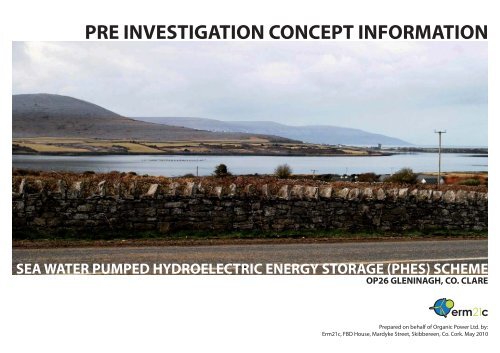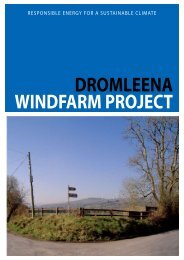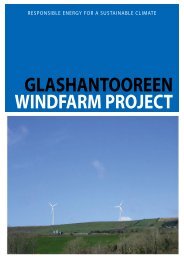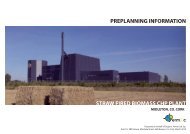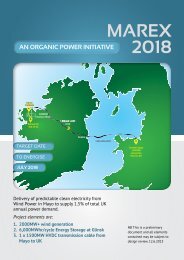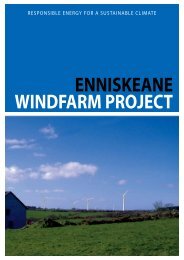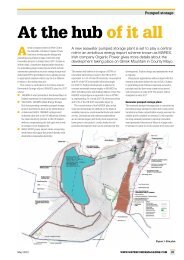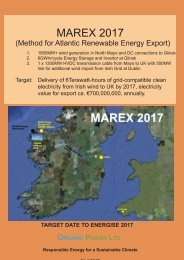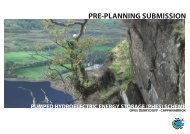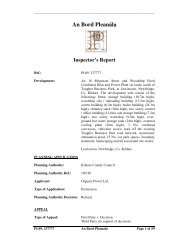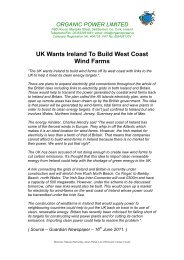PRE INVESTIGATION CONCEPT INFORMATION - Organic Power
PRE INVESTIGATION CONCEPT INFORMATION - Organic Power
PRE INVESTIGATION CONCEPT INFORMATION - Organic Power
- No tags were found...
Create successful ePaper yourself
Turn your PDF publications into a flip-book with our unique Google optimized e-Paper software.
<strong>PRE</strong> <strong>INVESTIGATION</strong><strong>CONCEPT</strong> <strong>INFORMATION</strong>OP26 GLENINAGH - CO. CLAREContents:Letter to Ballyvaughan Community Committee ........................................5Scoping Document ...............................................................................................9Concept Description ......................................................................................... 17Maps / Drawings: ............................................................................................... 25Site Plan .......................................................................................... 27Profile of Waterways ................................................................... 28Renewable Energy Hub ............................................................. 29Photomontages .................................................................................................. 31View from N67 at Bell Harbour Church .............................. 33View from Finavarra Martello Tower .................................... 34View from Ballyaban Viewpoint on the R480 ................... 35View from North end of Gleninagh mountainlooking down on the tetrapod structure ........................... 36Response to Questions presented by the BallyvaughanCommunity Committee ..................................................................................... 39Note: All designs, figures, calculations, maps and drawings in this document shouldbe treated as approximate, and needing confirmation by baseline assessment andadaptive design.3
14Design Inputs required for the evaluation of the likelihood and significance of the above:1. Existing Topography.2. Existing and proposed site levels.3. Plan and elevation drawings of development.4. Existing terrestrial and marine flora and fauna.5. Habitats directive assessment.6. Landscape photography and visual impact analysis.7. Ambient noise measurement.8. Hydro-geological survey, including karst mapping and well monitoring.9. Archaeological survey and investigation10. Details of air treatment provisions (noise).11. Employment requirements.12. Operations schedule, security, and environmental management provisions.13. Post operation management restoration proposal.9.2.2 In addition, the following information would be provided, in the context of the EPA (1995) AdviceNotes on Current Practice in the preparation of Environmental Impact Statements: Water Managementprojects for Agriculture, Water impoundment (including for hydroelectric generation), Canalisation,Flood relief. (Project Type 12).This document states: These project types can give rise to significant impacts, which can be direct, such aschanges in land use and habitats, or indirect, such as facilitation of new developments (industry, agriculture,infrastructure) which may in turn impact on the environment.Project DescriptionChecklist of items to be described:Construction• Site evaluation/testing.• Time of year, duration and phasing.• Site preparation works.• Employment.• Accommodation.• Working hours.• Acquisition of lands and management prior to development.• Dredging/excavation and spoil deposition.• Construction techniques.• Water course diversions (temporary).• Pipe laying.• Materials (including sourcing, transportation and storage).• Extensions of infrastructure (water, power, roads, etc.).• Access.• Dust, noise, traffic, vibration.• <strong>Power</strong> line connections.• Pipe laying.• Spoil deposition.• Fencing.Operation (including relevant alternatives)• Operational range of water levels.• Operational range of flows.• Seasonal/Daily variations of operations.• Monitoring and control procedures.• Maintenance systems.• Principal structures, including impoundment structures, access, pipelines, power lines, diversionchannels, control mechanism, buildings and fences.• Maintenance.Decommissioning (if applicable)• Safety.• Proposals for alternative usage/demolition following closure.• Reversibility of impacts.Growth• Opportunities and likelihood of expansion.Associated developments• Intensification of or new land uses.• Re-housing of displaced residences.• Connections to main transmission network (though this may be the subject of a separate application forpermission).• Water pipes.• Adjustment of affected infrastructure.Environmental EffectsTypical significant impacts likely to affect:Human beings• Displacement (major water improvement projects).• Creation/loss of amenity.• Community severance.• Changes to land use and settlement patterns.Flora• Alterations to habitats due to flooding/drainage.• Indirect impacts due to altered land use practices.• Aquatic and terrestrial species should be considered.Fauna• Displacement due to altered habitat.• Disturbance during construction.• Effects of changes in water quality and flow regime.• Effects due to changes in Flora.Soils (and geology)• Erosion.• Excavation/deposition of soil.• Loss of/changes to soil.Water• Changes to the physical, chemical, and biotic characteristics of water bodies.• Effects on flow regime.• Changes to water table.Air• Dust generation (particularly during construction).
Climate• Reduction in occurrence of mist and fog due to drainage of wetlands.• Local climatic effects, particularly regarding temperature and evaporation due to creation of a reservoir.The Landscape• Direct effects arising due to spoil deposition, dam construction and machinery presence during construction.• Indirect impacts occurring due to factors such as power lines, water mains and treatment works andchanges in land use.Material Assets• Roads.• <strong>Power</strong> supply networks.• Water supply.• Potential uses of water resources.Cultural Heritage• Flooding of monuments, artefacts and settlements.• Disturbance of items of historical importance such as bridges and weirs.• Significant changes in long established land-use patterns.The interaction of the foregoingPossible Mitigation Options• Siting and Design alternatives.• Water usage rates.• Routing of infrastructure.• Bank protection.• Habitat creation.9.3 LengthIt is anticipated that the Main Body of the EIS would run to approximately 50 pages of A3 text not includinggraphics, and that the appendices would run to several hundred A3 pages.10 Membership and management of the EIA teamThe core team members of baseline investigations are listed below. It is hoped that local expertise could beincorporated into the team.Erm21c Ltd Project Management, EIA management, and EIS productionProject Manager: Axel FabritiusEnergy Engineering James J. Nolan, Sean WyseCivil Engineering Brian Walsh, Niall Fitzsimons & Co.Soils and Geology Robert MeehanHydrology Robert MeehanArchaeologist Maurice HurleyNoise & Vibration Dixon BrosnanEcology John Meade11 Work plan and resourcing for the environmental studies• Baseline studies commence June 2010 pending community council endorsement.• Project defined June 2011.• Design and Pre-planning consultations to be completed December 2011.• EIS to be completed and anticipated planning application June 2012.15
OP26GLENINAGH - CO. CLARE<strong>CONCEPT</strong> DESCRIPTION<strong>PRE</strong> BASELINE STUDIES17
1 The Concept1.1 Site Location And Suitability1.1.1 Site LocationThe concept location of the project is on the North Clare coast, at Gleninagh, Mountain approximately 5km WNWof Ballyvaughan town. Site coordinates to locate are Irish Grid 117885E, 209301N.The two concepts are screened and ranked in the table below with the highest scoring in each criteria highlightedin yellow.Criterion Laghtea GleninaghVolume Potential 2million m³ 13 million m³Adequate head and L/H ratio 7 3.3Environmental compatibility Probably incompatible Potentially compatibleDistance to 220Kv Node 25KM 45KMLength of New Road Required 700m 2100mVisibility From Scenic Route Low Very LowTotal score 2 4Gleninagh, Co. Clare ranks as more suitable as is apparent from the table. Therefore it has been selected for detailedevaluation.1.1.4 Baseline Studies Required to evaluate the validity of the concept prior to developing a proposalGleninagh Mountain Gleninagh Mountain top1.1.2 Site Selection Suitability CriteriaThis site has been selected from 2 alternatives based the proposed development because of the following site criteria:• Volume Potential.• Adequate Length to Height (L/H) ratio and sufficient vertical head to use for gravity flow (>180m gross head).• Compatibility with existing environment (Proximity to housing, habitat sensitivity, disturbance).• Proximity of 220/400kV node.• Length of new road required.• Visibility from scenic route.1.1.3 Screening Of Potential SitesTwo locations were screened for the concept according to the criteria set out in section 1.1.2 above. They are:• Laghtea Hill, Portroe, County Tipperary - using an elevated site at Laghtea Hill 173500E, 178500N for thetop reservoir and Lough Derg as the lower reservoir.• Gleninagh, Co. Clare - using an elevated site at Gleninagh 118000E, 2095000N as the top reservoir andthe Atlantic as the bottom reservoir.The following baseline studies would be undertaken for 12 months prior to development:• Hydrogeological & Hydrological studies including year long well monitoring and karstic hydrogeology andspeleological mapping• Geophysical profiling• Civil Engineering• Noise• Archaeology• Terrestrial Flora & Fauna• Marine Flora & Fauna• Birds• Habitats Directive Assessment• Visual Impact assessment1.1.5 Scale Of The ConceptThe scale of the concept has been dictated by a combination of infrastructure related, environmental, andeconomic issues.• The development must be located in an area where open loop hydropower schemes are compatible withcurrent land and sea uses.• The required setback distances to avoid noise and nuisance impacts at houses will dictate, that to achievethe desired scale and visual context, the turbine hall would be located at a sufficient distance fromresidential housing.• The proposed development must be compatible with the sensitive nature of the landscape and habitats ,not affecting biodiversity, visual prospects or scenic routes.• The proposed development must not materially affect important hydrological resources.The area proposed for the concept lies within a karstic limestone area with associated dissolution featuresand hydrology.• The proposed development must have the inherent ability to produce zero net emissions (if suppliedwith input clean energy) to be able to provide 100% reliable clean power as an output.• The proposed development must, in as near as possible, be of a scale that can partially and significantlysatisfy the requirements of electrical generation capacity backup equivalent to the mean production ofexisting and proposed wind power projects proposed for 2020. This would allow the combination of windand PHES to provide clean reliable power.19
• The development must be located within a reasonable distance of a suitable grid connection for theexport of electric power.• There are two national monuments recorded on Gleninagh mountain of archaeological significance.These are listed as a possible house and enclosure of indeterminate age (002/0060001 and 002/006002).These structures must be protected. Investigations would be carried out to ensure any proposal wouldinvolve protection for these monuments, and to identify any other archaeological remains which mightbe impacted by the concept, if developed.income for many of the people living in the area and surroundings. No adverse impacts on theseactivities or the income and employment that they generate would arise as a result of the development.• Extant rural dispersed housing is an existing use of this environment. While this use is a modification ofthe landscape and environment, when properly sited and built, housing is not an incompatible use of therural landscape, and would be unaffected by the development, due to distance.• Wildlife use of the proposed site is expected to be found to be low.• The unaffected continuation of recreational uses of the greater landscape area such as hunting, hill andcountry walking, scenic driving, and horse riding would be entirely unaffected by the existence of a PHESplant in the area.• The healthy and safe living conditions which exist in the area would continue to be enjoyed after a PHESplant is built, provided that the concept is correctly designed and operated to eliminate the potentiallynegative effects of noise, erosion, and dust.• Residential and agricultural property values would be unaffected by the development.• Existing public road infrastructure would not be materially affected as it is currently of sufficient standardto serve for the purposes of construction traffic.20Archaeological monuments on Gleninagh Mountain Karst pavement on Gleninagh Mountain1.2 Expected Impacts1.2.1 Do-nothing scenarioIn the preparation of an Environmental Impact Statement the implications of a Do-Nothing scenario should be takeninto account. The main economic and environmental benefit that would derive from the proposed PHES conceptwould be the provision of energy storage which can be delivered to the grid as dispatchable electric power, at timeswhen demand exceeds base load supply thus allowing wind power to deliver to storage at times when it wouldotherwise be curtailed. It is the intention to supply the input energy from wind energy in totality, which would makethe exported energy green, resulting in the avoidance of nearly 2,000,000 tonnes carbon equivalent emissions fromreduced fossil fuel combustion and the production of 2.8TWhr (2.8 million MWhrs) of reliable clean electricity peryear.In order to be justified, a do-nothing scenario should demonstrate that the decision to pass up this benefit is justifiedby the retention of existing environmental benefits which would be lost as a result of the development. There areno environmental benefits accruing from the production of this energy from fossil fuel powered plants which wouldhave to produce the peak load power to replace the proposed energy storage if it is not commissioned.We must do something about climate change by reducing carbon emissions and this proposed renewable energydevelopment would make a significant contribution to that goal.In order to assess the relative benefits of a do-nothing scenario versus a decision to proceed, the existingenvironmental benefits which would be unchanged, and those that could be negatively affected need to beidentified, and if possible, quantified.1.2.2 Negligible ImpactsThe following environmental benefits of the area would be unaffected by the development:• The tourism sector is the main source of income for the majority of the people living in the area andsurroundings, based on the unique characteristics of the burren landscape. The concept would also be atourist attraction to the area with an onsite visitors centre to provide access to the stunning panoramicviews.• The primary sector (agricultural activities, sheep, forestry, and fishing) is also a significant source of1.2.3 Positive ImpactsThe following environmental benefits of the area would be positively affected by the development:• Direct local income from sustainable use of the environment would increase significantly, enhancing the economicintegrity and security of the area, including a minimum 1 high quality sustainable job in monitoring, and indirect jobcreation through management. Total permanent job creation would be equivalent of 2 full time jobs.• The facility would require the construction of access roads, a turbine hall, penstock, upper reservoir andtetrapod mound wave attenuation structure resulting in significant local economic activity during theconstruction period.• The concept would yield investment return for local and company investors. The facility would befinanced through a prudent combination of debt and equity.• Strategic energy infrastructure which would be emissions free and imported fuel independent, consistentwith EU, State, and County policy would be commissioned, enhancing the future energy security of thecommunity.The concept can be examined for potential to integrate into the scenic tourism assets of the region, by providinga destination in its own right, and opening up access to the stunning views afforded from the mountain, andthe possible incorporation of a visitor’s centre with associated employment opportunities.1.2.4 Negative ImpactsThe following environmental benefits of the area may be potentially negatively affected by the development:• The local visual impact would be minimal.The upper reservoir would change the profile of the mountain as viewed from a distance. Seephotomontages.• The current use of the portion of the site used to accommodate the reservoir for grazing cattle would be lost if thesite is developed.• The existing peat in the area to be used for the upper reservoir would be moved and relocated onsite, subject to baseline assessment and adaptive design.• Existing karst pavement would be lost, it would be studied whether associated floral habitat can bereplaced on the outer bank of the embankments proposed for the reservoir.As is evident from the above list of impacts arising, the benefits that would be foregone in a do-nothing scenarioare significantly greater than the loss of benefits which would result from the development. An attempt to quantifythe economic costs and benefits on an annual basis is given below.
Annual National Economic Cost-Benefit Proposed PUMPED HYDRO ELECTRIC STORAGE SCHEMEItem Cost BenefitNational Fuel import costs avoided on reduced oil imports0 188,595,000(2.5146m barrels year @€75/barrel, based on gas power)National Carbon Payments avoided €16 x 2,000,000 tonnes 0 32,000,000Lost cattle grazing (assuming an average 1 cow/1ha,64ha lost, cattle @70) 4,480 0National Economic Totals 4,480 220,595,000• The net national economic benefits over 50 years would be in the order of €11,029,526,000.• A Do-nothing scenario would result in the avoidance of potential savings on the national obligation topurchase fuel and carbon emissions rights worth over €11 billion, over fifty years.• The concept if developed, would not have any detrimental permanent environmental impacts on thearea or surroundings, if properly designed, and operated.• There are no environmental benefits from a do-nothing scenario.In conclusion, a do-nothing scenario should not apply in this case. This is the century where the whole worldis starting to take corrective action against anthropogenic climate change, and to start developing towards asustainable future. In this new world paradigm, the generation of electricity, a commodity that everybody enjoysand nobody wants to give up, will largely come from low carbon renewable energy, and North Clare is endowedwith the necessary natural resources., equivalent to an oil well producing over 10,000 barrels per day with none ofthe associated emissions or environmental problems.1.3.3 Access RoadsThe following sequence of on site road construction would be required:• Build new road to access powerhouse.• Build new road to reach top reservoir.• Roads on dam crest.• Ramps onto crest and ramp down to reservoir bed.Access roads into and within the site would range from 4.5m to 6m width and would be laid using 500mm of 50mmaggregate down. Some sections of this road would be finished with tarmacadam. Stone would be obtained fromquarrying stone during lake excavation, and no imported stone would be required.1.3.4 StructuresThe concept would be a large civil engineering project, if developed, involving heavy structures to contain theforces of standing and contained flowing water, in addition to the pump turbine. All structures would be designedby one of the leading structural engineering practices in the country, Niall Fitzsimons and Company, ConsultingCivil and Structural Engineers. The structures required are described below. Detailed foundation design would becarried out post obtaining planning permission.Peat StorageIt would be intended to investigate the relocation of the existing peat and its associated vegetation on exposedpavement elsewhere on Gleninagh Mountain to conserve the ecological services provided by this habitat.1.3 Construction outline, pending baseline studies and adaptive design1.3.1 Public Road AccessAccess to approach the site would be via Ballyvaughan on the R477 and there are two access alternatives whichwould be evaluated:via the N67 through Kilcolgan and Kinvara to Ballyvaughan and the R480 to Ballyvaughan• via the R476 from Ennis through Corrofin and the R480 to Ballyvaughan1.3.2 Site Compound, Temporary Site OfficesAt the initial stages of construction, the area for the site offices and compound would be stripped of topsoil andthis would be banked around the area. Teram geotextile would be placed on the subsoil to stop the particlesboiling up through the two layers of compacted clause 804. Included in the compound would be parking forfifteen cars/vans, bunded diesel storage to 110% of the largest tank and a concrete area with gull to a grease trapand silt trap to catch spills and sediment. A perimeter hoarding 2.4m high, would be constructed and paintedgreen to match the existing surroundings of trees and green area.Peat on Gleninagh Mountain Possible site for relocation of peat on Gleninagh MountainGravity Dams For ReservoirsDams would be constructed using excavated stone placed on appropriately designed rock benches. As the nameinfers, the force of gravity is used to provide structural integrity.Temporary site structures would consist of ten port-cabins and six small lockable steel shipping containers forsmall plant and hand held tool storage, and personnel protective equipment (PPE) storage. One of the port-cabinswould be for the subcontractors that are expected during the construction period, and the other would be a largerone for canteen and meeting room. A toilet unit would also be provided and regularly maintained and contentdisposed of by a registered waste management company. The waste management would also provide a numberof skips/ large bins for recyclables and non recyclable materials that would be generated on site and within thecompound.Cliff face at Gleninagh Shore21
ReservoirThe upper reservoir would be constructed on the existing bedrock, and foundations would be blasted partly intothe rock. A porous drainage layer would lie on top of the bedrock to allow for the control of groundwater seepage.This is overlaid by an impermeable flexible composite of bituminised concrete and bitumen. The leakage tolerancefor freshwater reservoirs is 5l/s from an economic point of view. For seawater schemes there is a 0l/s tolerance,which if not achieved with the primary sealing system, would be achieved from the secondary sealing systemlocated below the drainage layer. The seawater collected from the drainage layer would be returned via pumps tothe reservoir. There would be no leakage from the reservoir.Intake structuresA sluiced water intake/fill structure would be constructed below sea level from re-inforced concrete to allow waterto be extracted and pumped to the reservoirs. The intake structures tailrace pipe would be constructed to a depthof approx. 40m below sea level to provide sufficient back pressure on the pump-turbine to eliminate cavitation.Appropriate sluice controls and trashracks would be included. The water would come from the open Atlanticthrough a tetrapod mound wave attenuation structure arranged in a semi circular breakwater, with two mainfunctions: a) to minimise wave erosion and reduce water level fluctuation during pumping and b) to dissipate theenergy of the exiting water post generation and protect the existing marine habitat.PenstockA penstock pipe of internal diameter 8.25m would transport the water at a rate of approx. 360m 3 /s betweenreservoirs. This pipe would be constructed by tunnelling underground, minimising environmental disturbances.The pipe would be composed of reinforced concrete tunnelway 840m long.1.3.5 External Service Pipes And DuctsAll telecommunications and electrical cables for the proposed development would be buried underground underthe access roads on site with a minimum of 1 meter cover from ground level, labelled with suitable yellow warningtape at 0.5m from ground surface and 0.8m from ground surface at the top of the surround gravel to warn offfuture excavations. Electrical cables would be run to a substation adjacent to the turbine hall. The 220/400kVwhich may be AC or DC underground or undersea cables would follow one of the routes indicated on the map.1.3.6 Site Works SurfacingThe access roads would be paved with tarmac or finished with crushed stone, and may have kerb and gullies tocollect storm water runoff to sedimentation basins, subject to information gained during baseline studies.1.3.7 Plant Operational Technology Installation And Mechanical And Electrical Fit-OutDesign parameters:• Location to minimize bends in the penstock pipes• Location of turbine below sea levelTurbine• Pump-turbine (Voith Siemens/Hitachi/Toshiba)• 4no.• Rated output: 240 MW• Turbine rated net head: 330m• Required flow rate 360 m³/s• Max. pump Head: 302.5m• The power plant would run fully automatically.1.3.8 Construction TrafficPump Turbine Schematic Drawing (Indicative Only)22Example inspection gallery with emergency drainage system visible,located at Yanbaru, Okinawa, Japan Sea Water PHES<strong>Power</strong>houseA cavern containing the 4 number 240MW pump turbines would be constructed approx 40m below sea level, atthe northern part of the site, beside the coast. This cavern would be accessed by a vertical access shaft (approx60m deep) from the surface of the ground above.TailraceThe cavern would be connected to the sea by approx. 100m long intake structure located below sea level. Thewater in the chasm would come from the open Atlantic through a tetrapod mound wave attenuation structure.Example of a Tetrapod Mound Wave Attenuation Structure, located at Yanbaru, Okinawa, Japan Sea Water PHESConcept generated traffic would include deliveries of plant and machinery and of oversized loads. The oversizedloads would not require public road alterations. The transportation of these loads would require special permitand the consent of ‘An Garda Siochana’. Once these have been obtained the components would be transportedfrom port to site. There would also be daily commutes of plant operators, office staff, electricians, engineers andtrades people. Assuming 20 no. workers, all travelling in their own vehicles, there would be an increase of 20vehicles commuting daily.1.3.9 Construction Health and SafetyRelevant legislation includes, ‘The Safety, Health and Welfare at Work Act 1993-2003, Irish Construction regulations2001, and all of the other up to date Safety, Health and Welfare best practice Guidance Documents. A number ofthese relevant documents include PPE, Manual Handling, Working with ladders, working at night, quarrying andsurface mining operations, quarry vehicles, working on in or near excavations, signage, slips trips and falls atwork, working at heights. This is not an exhaustive list, however, these are all relevant to a large project such asa PHES development. Hazards identified associated with this concept include, oversized loads, lifting materials,pipe sections and turbine components to heights, working at heights, underground power lines, electricity atcommissioning, excavations, slips, trips and falls, moving vehicles and plant, etc. A 2.4m high perimeter chain linkfence would be carried out around the reservoir perimeters.
1.3.10 WaterworksTop ReservoirDesign:• Gravity Rockfill Dam.• Reservoir Bed: asphaltic liner (e.g. top to bottom: with mastic coating, asphalt concrete, bituminizedbinder course, asphalt filter, asphalt binder, gravel layer).• Reservoir embankment sealed with EPDM rubber sheet liner.• Drainage system to monitor possible seepage and a fibre optic leakage detection system.• Intake structure: Sluice gate embankment placed.• Freeboard: 0.5 m (based on max. wind speed ever recorded in Ireland [56 m/s] 300m fetch, 15m depth).• Wave wall 0.5m high on upstream edge of the dam.PenstockDesign:• 1 constructed pipe tunnel with as few as possible direction changes. Changes of less than 10° are moreor less negligible in terms of friction, bigger changes would cause increasing friction meaning a loss inefficiency• Internal Pipe diameter 8.25m.• Pipe material: epoxy coated reinforced steel concrete structure.Stilling Basins (sedimentation ponds)Design:• 3 basins in a row at three different height levels (“steps”)• Position: Below rock excavation and peat storage areas1.3.11 Grid Connection OptionsThere are three options which would be examined in detail to connect this project to the grid:1) Underground via Corofin road to 400kV near Ennis.Reservoir at Yanbaru, Okinawa, Japan Sea Water PHES showing rubber sheet liner2) Underground via N67 to 400kV near Ardrahan.3) Undersea to 400kV at Ardrahan.4) Undersea to 220kV and possible 400kV at Casla.1.3.12 Environmental ConservationThe following Annex 1 Bird species: Merlin, Chough, Peregrine, Hen Harrier and Golden Plover and the Red Databook species Yellowhammer are present on the northwest Clare coastal area, within which the concept site islocated. In order to help the conservation of these bird species if the concept was developed the followingmeasures would be studied for potential implementation:Top Reservoir - Road on Dam Crest (Waldeck II, Germany)(Indicative Only)Top Reservoir - Gravity Rockfill Dam with partly vertical steelinforced walls (Waldeck I) (Indicative Only)• Stock proof burren walls could be erected on the cliff edge to allow cliff vegetation to grow properly andprovide excluded nesting areas for birds.• Wet grassland with pools could be created in peat storage area to encourage heath nesting sites for Snipe,Golden Plover, and egg-laying sites for Frogs.• Hazel scrub growth could be encouraged to expand habitat for Woodcock and to facilitate raptor foraging.• Alpine flora habitat could be recreated on the outer face of the reservoir embankment.View of PHES reservoir View from reservoir looking down over town1200MW PHES at La Muela - Cortes de Pallas, Valencia, Spain1200MW PHES at La Muela - Cortes de Pallas, Valencia, SpainExample reservoir embankment23
The following important species of flora: Bearberry (Arctostaphylos uva-ursi), Hoary Rock-rose (Helianthemum), PyramidalBugle (Ajuga pyramidalis), Crowberry (Empetrum nigrum), Mountain Avens (Dryas octopetala), Wintergreen(Pyrola media) and Round Prickly-headed Poppy (Papaver hybridum) have been identified in the North West Clarecoastal area, within which the site is located. The important butterfly species Brown Hairstreak and Pearl Bordered Fritillarycan also be found in the area. Rock crevices in the reservoir embankments and surrounding areas would be filledwith soils removed from the mountain to encourage regrowth of the local flora. This would also prevent soil erosion.The concept site area is part of the Special Area of Conservation (SAC) and proposed Natural HeritageArea (pNHA) Site Code 000020, Black Head -Poulsallagh Complex. <strong>Organic</strong> <strong>Power</strong> Ltd. intends toengage fully with the National Parks and Wildlife Services (NPWS) and local environmental groups toinvestigate the potential for effective and satisfactory mitigation for any habitat loss or disturbance.1.4 Operations1.4.1 OverviewThe concept Gleninagh, Co. Clare sea water PHES concept would be commissioned to supply electric power from4 hydroelectric pump-turbines, to be produced by pumping 16,500,000 meters cubed water to a gravitationalhead of approx. 300 meters using approx. 960MW of electric power sourced from the grid during off peak hoursof electricity demand, and drawing down this head while producing approx. 836MW of power from the turbineswhich power is delivered to the grid during peak hours. All of the input electric power would be sourced from gridconnected wind and wave energy projects. The process would transform unpredictable and variable windpowerto reliable, dispatchable clean energy delivered to the grid.1.4.2 Electric Energy1.3.13 Construction TimetableFlora on Gleninagh MountainThe following approximate construction schedule would start within 12 months of receipt of planning and gridpermits, if lodged. If construction started, commissioning would be projected within 30 months.The filling of the reservoir to an operational level would take 15-24 weeks depending on the precipitation levels.The PHES scheme would deliver power 9.75 hours per day, corresponding to peak demand from 0600-1030 and1615-1930. The scheme would accept energy off peak for 4 up to 20 hours per day depending on the availablewind energy. Energy is lost in the process through resistance and less than 100% efficiency in the pump andturbine. These losses are more than compensated both in value and power quality, by the fact that intermittentand unpredictable power is delivered via PHES as a predictable quality product in time and volume. The amountof wind energy capacity that would need to be available to supply the scheme is approximately 2500MW installedcapacity of wind turbines, assuming that the wind turbines are on average 31% efficient, and that the PHESrequires a minimum of 10,370MW hours per day over 14 hours, requiring an average input of 780MW. In theevent wind power is not available for the scheme, it would add energy efficiency potential to existing fossil fuelplants which would enable the conservation of up to 50% of the energy produced nationally which is currentlywasted due to over production.1.5 EmploymentActivity1) Site access Clearance & SiteCompound Setup2) Construct access road3) Rock/ soil / peat excavation4) Construction of Turbine Cavern5) Upper Reservoir soil/peatexcavation6) Upper Reservoir rock removal &formation of banking /retaining walls7) Construction of Upper ReservoirInlet Structure8) Excavation & tunelling works forpipe line path9) Construction of High-PressurePipeline from upper to lowerreservoir10) Apply water tight asphalt liningto upper reservoir and rubber sealerto embankment11)Fit-out of Cavern- Pump Turbine,Generator etc12) Construction & fit-out ofTransformer building13) Laying underground/overground high voltage cable fromsite to nearest local network14) Testing/CommissioningTable 1: Proposed Construction Schedule – Gleninagh, Co. Clare PHESDuration (Months)1 2 3 4 5 6 7 8 9 10 11 12 13 14 15 16 17 18 19 20 21 22 23 24 25 26 27 28 29 30When operational, the plant would require 1 part time supervisor, and the equivalent of 1.5 full time technicalstaff for maintenance and management. The total full time job creation would be 2.1.6 DecommissioningIt is current practice to re-commission PHES plants once the technical life of its components is over, due to theincreasing penetration of wind power into power grids. For example, many schemes in mainland Europe whichwere built in the 1930s are now being re-tooled and upgraded after 70 years of operation (i.e. Waldeck 1 PHES,Hessen, Germany, owned and operated by EON).However, in the event that decommissioning is warranted for unforeseen superseding of the technology byadvances elsewhere in power systems, the following would be undertaken as decommissioning:• All roads and structures would remain in place for future re-use.• The top reservoir would be maintained empty, and habitat recreated on top of the reservoir bottom forrelevant flora and fauna.24World’s first Sea Water Pumped Hydro Electric Storage Scheme at Yanbaru, Okinawa, Japan
OP26GLENINAGH - CO. CLAREMAPS / DRAWINGSNOTE: ALL DRAWING ARE <strong>CONCEPT</strong>UAL AND SHOULD NOT BE USEDFOR ANY PURPOSE OTHER THAN TO ASSIST IN COM<strong>PRE</strong>HENDING THE<strong>CONCEPT</strong>.25
SITE PLAN27
28PROFILE OF WATERWAYS
RENEWABLE ENERGY HUB29
OP26GLENINAGH - CO. CLAREPHOTOMONTAGES31
PHOTOMONTAGESExisting ViewView after ConstructionView from N67 at Bell Harbour Church33
PHOTOMONTAGESExisting ViewView after ConstructionView from Finavarra Martello Tower34
PHOTOMONTAGESExisting ViewView after ConstructionView from Ballyaban Viewpoint on R48035
PHOTOMONTAGESExisting ViewView after Construction36View from North End of Gleninagh Mountain looking down onthe tetrapod structure
PHOTOMONTAGESView after ConstructionView from North End of Gleninagh Mountain looking down onthe tetrapod structure37
OP26GLENINAGH - CO. CLARERESPONSE TO QUESTIONS <strong>PRE</strong>SENTED BYBALLYVAUGHAN COMMUNITY COMMITTE39
ORGANIC POWER LIMITEDFBD House, Mardyke Street, Skibbereen, Co. Cork, IrelandTelephone/Fax: 003532851951; email :info@organicpower.ieCompany Registration No. 406133 ;VAT No.:IE6426133VORGANIC POWER LIMITEDFBD House, Mardyke Street, Skibbereen, Co. Cork, IrelandTelephone/Fax: 003532851951; email: info@organicpower.ieCompany Registration No. 406133 ;VAT No.:IE6426133V24th May 2010RE:<strong>CONCEPT</strong> Seawater PHESat Gleninagh, BallyvaughanThe following questions have been presented to us bythe Ballyvaughan Community Committee. Theresponses have been prepared by the followingprofessionals: Axel Fabritius, MS Geophysics EurGeol. Dr. Robbie Meehan, PGeo James Nolan, BE Maurice McCarthy, MS Oc (MRM) Leo O’Driscoll, FCA, BBS1) Why use Sea Water instead of fresh water?The volumes required for pumping and generating inPHES schemes that are sized to meet the current andfuture grid requirements in Ireland are in the order of 10million cumecs. This amount of freshwater is simply notavailable in Ireland without incurring unacceptableenvironmental impacts. The use of seawater avoidsthese impacts as the bottom reservoir has essentiallylimitless and available volume (Maurice).2) What about leaks?The 5 l/s are referring to an economical point of view - i.e.loosing more water would be uneconomical - and thatapplies mainly for fresh water reservoirs. Modern state ofthe art fresh water reservoirs have a leakage tolerance,which can be as low as below 1 l/s (this has to be set inrelation to the size of lined area). However, for seawaterPHES schemes a 0 l/s tolerance applies. (Axel)3) How do you assemble the large area of rubberlining to ensure there are no leaks?All water retaining structures, where leakage is critical -such as for a seawater PHES - have a controlled sealing,regardless of the type of the sealing (rubber sheeting,asphaltic or concrete lining). What does that mean? Itmeans that, below the primary sealing there will be acontrolled drainage layer on top of a secondary sealinglayer. If the primary sealing should fail for what everreason, the water is collected in the drainage layer and ifrequired returned to the reservoir. The capacity of thedrainage layer is designed in such a way that water willrun pressure free and therefore, there will be no stress onthe secondary sealing layer. The water run off of thedrainage layer will be monitored automatically and in caseof water in the drainage system the fibre optic leakagedetection system is activated. This can detect leaks assmall as 0.01 l/s. Because of the nature of the drainagelayer, which has a similar effect as a sponge on water,even the first filling of the reservoir will not cause leakageinto ground underneath the reservoir.Directors: Maurice McCarthy, Brian Walsh, James Nolan, Leo O’DriscollDirectors: Maurice McCarthy, Brian Walsh, James Nolan, Leo O’Driscoll41
ORGANIC POWER LIMITEDFBD House, Mardyke Street, Skibbereen, Co. Cork, IrelandTelephone/Fax: 003532851951; email :info@organicpower.ieCompany Registration No. 406133 ;VAT No.:IE6426133V<strong>Organic</strong> <strong>Power</strong> Ltd. designs its seawater PHES schemeswith controlled sealing layers - using asphaltic linersand/or rubber sheeting (geomembranes). For examplesand references of rubber sealings in hydro constructionsplease check www.carpitech.com. (Axel)4) Why lease full folio numbers rather than strips ofland for the roadway, shaft and reservoir?The land leased for a project such as this is usually sharedbetween several landowners, in greatly differingproportions. In order to attain a level of equality betweenlease earnings, the process adopted is to lease more landfrom the smaller landholdings required. In addition,leasing more land, particularly for roads and penstockroutes ensure flexibility during design phase pendingresults of baseline surveying. (Maurice)5) Why have the Japanese not built any sea waterpumped hydro stations as this one is supposed to bean experimental plant built 18 years ago.Since Japan is surrounded by sea and they have rockycoast lines, Japan is a natural place for building PHESs.As a consequence they proved the feasibility of seawaterPHES in Japan. The plant was completed in 1999 andunderwent a five year test operation. So the plant workscommercially only since 2004. If one knows the Japaneseenergy market, Japan does not need further PHESs. Butshould need arise, they have the technique readilyavailable. Seawater PHES plants are currently underevaluation in Indonesia, Cyprus, the UAE, and the UnitedStates. (Axel)ORGANIC POWER LIMITEDFBD House, Mardyke Street, Skibbereen, Co. Cork, IrelandTelephone/Fax: 003532851951; email: info@organicpower.ieCompany Registration No. 406133 ;VAT No.:IE6426133V6) Will the water coming from the bore hole inNewtown become salinated due to leaks in thereservoir?Since there is no leakage into the underground (seeparagraph above) there will be no salination either. (Axel)7) As the limestone is so full of aquifers and holes willit allow salt water all the way back under the land andbring loads of sea water into the valley andcontaminate the ground water there when the shaftand tunnel are made?Similar to the reservoir sealing the shafts and the tunnelsof the scheme will have controlled sealing layers andtherefore there will be no leakage and hencecontamination into the underground. (Axel)8) How will the power be transmitted – over head orundersea?As Bord Pleanala are currently examining this with apublic forum and there are many conflicting theories,rather than re-hash them here we would rather await theresult of the enquiry as it will have an effect on futureconnection to the grid and expansion of same. (Jimmy)Directors: Maurice McCarthy, Brian Walsh, James Nolan, Leo O’DriscollDirectors: Maurice McCarthy, Brian Walsh, James Nolan, Leo O’Driscoll42
ORGANIC POWER LIMITEDFBD House, Mardyke Street, Skibbereen, Co. Cork, IrelandTelephone/Fax: 003532851951; email :info@organicpower.ieCompany Registration No. 406133 ;VAT No.:IE6426133V9) Eirgrid have no plans for undersea cables or 440kvlines to Casla due to cost, maintenance and safetyreasons. How do <strong>Organic</strong> <strong>Power</strong> propose to addressthis?As above (Jimmy)10) Why did <strong>Organic</strong> <strong>Power</strong> not consider Mount Callanas a better location as it is higher and there is a finebig lake there (Doolough lake).Mt Callan is too far from the sea for a seawater system, AFW system is already being studied at that location byanother company. We understand that the extra costsassociated with constructing 2 new reservoirs, theunsuitability of existing lake for PHES use and issues withpeat removal are major obstacles for this project(Maurice).11) Will the scheme withstand tremors?The technology for designing and building dams andappurtenant structures that can safely resist the effects ofstrong ground shaking is available. Regardless, Ireland(especially the southwest) is a region of low seismicactivity (www.dias.ie/irish_seismicity), the dams, as withthe entire schemes, will be built to safety standards, whichcomply to international regulations. The following designbasis will be used: Maximum Credible Earthquake (MCE),Maximum Design Earthquake (MDE) or Safety EvaluationEarthquake (SEE): Strictly speaking, the MCE is adeterministic event, and is the largest reasonablyconceivable earthquake that appears possible along aDirectors: Maurice McCarthy, Brian Walsh, James Nolan, Leo O’DriscollORGANIC POWER LIMITEDFBD House, Mardyke Street, Skibbereen, Co. Cork, IrelandTelephone/Fax: 003532851951; email: info@organicpower.ieCompany Registration No. 406133 ;VAT No.:IE6426133Vrecognized fault or within a geographically defined tectonicprovince, under the presently known or presumed tectonicframework. But in practice, due to the problems involved inestimating the corresponding ground motion, the MCE isusually defined statistically with a typical return period of10,000 years. Thus, the terms MDE or SEE are used assubstitutes for the MCE. The stability of the dam must beensured under the worst possible ground motions at thedam site and no uncontrolled release of water from thereservoir shall take place, although significant structuraldamage is accepted. In the case of significant earthquakedamage, the reservoir may have to be lowered (Axel).12) How will the shaft with 180tonnes of water persecond travelling down it, withstand a tremor?As for the reservoir embankments - the shaft will be builtto maximum safety criterias and a hole (the shaft) in themountain will not cause any, whatsoever, stabilityproblem. (Axel)Once the criteria Axel has outlined above are adhered tothere should be no issues. (Robbie)13) How can <strong>Organic</strong> <strong>Power</strong> be sure the mountain canhold 13.6million metric tonnes of weight from GalwayBay?Again once the EIA is completed to best standards andthe relevant characteristics of the rock determined, theengineering design can ensure no adverse effects.(Robbie)Directors: Maurice McCarthy, Brian Walsh, James Nolan, Leo O’Driscoll43
ORGANIC POWER LIMITEDFBD House, Mardyke Street, Skibbereen, Co. Cork, IrelandTelephone/Fax: 003532851951; email :info@organicpower.ieCompany Registration No. 406133 ;VAT No.:IE6426133VORGANIC POWER LIMITEDFBD House, Mardyke Street, Skibbereen, Co. Cork, IrelandTelephone/Fax: 003532851951; email: info@organicpower.ieCompany Registration No. 406133 ;VAT No.:IE6426133V14) How will ecology be addressed?EIS (all)15) Why not buy the land from the landowners atagricultural rates instead of 50 year leases?The reason that <strong>Organic</strong> <strong>Power</strong> enters into leaseagreements is to facilitate the farmers retaining ownershipof their lands. For example with the Mayo project only 60acres approx out of a total ownership of 300 acres wasrequired. 3 different landowners owned the lands thatwere required to build the project but only portions of thelands were required. The farmers can once the project hasbeen constructed use the lands that are not occupied bythe PHES. It also is more lucrative for the landowners toretain the lands and gain a yearly income from the rentalof the lands. It has proven very difficult in the past topurchase land at agricultural prices when the owners knowthat a commercial venture is being established on thelands. (Leo)17) Why propose a scheme of this scale withouthaving had meetings with the Clare County Council,the National Parks and Wild life service and all theother relevant public agencies. Have <strong>Organic</strong> <strong>Power</strong>considered the ramifications of their proposal on thecounty development plan, the Eirgrid long rangeplans, Burren life's policy etc?All investigations referred to above will be carried out andassessed in the context of the existing environment aspart of EIS. <strong>Organic</strong> <strong>Power</strong> wants community feedbackfirst before investing in the baseline studies, or wastinggovernment time. (Maurice)18) How long will the project take from concept tocompletion?If permits are sought at the end of 2011, it is anticipatedthat work could commence by mid 2013, for completionand commissioning in early 2016 (Maurice).16) What is the Motivation?<strong>Organic</strong> <strong>Power</strong>’s motivation is to profitably construct andoperate PHES to accommodate the development of nonfossilfuel dependent present and future wind generationand provide energy efficiency services to existing fossilgeneration (Maurice).19) Is <strong>Organic</strong> <strong>Power</strong> going to buy free power from thewindmills at night and sell it dear the following day?The head of Eirgrid stated that there is no such thingas free power for the obvious reason that theenormous capital cost must be recouped.Obviously its not free but is a system of arbitage, which isa company business matter with our partners (Jimmy)Directors: Maurice McCarthy, Brian Walsh, James Nolan, Leo O’DriscollDirectors: Maurice McCarthy, Brian Walsh, James Nolan, Leo O’Driscoll44
ORGANIC POWER LIMITEDFBD House, Mardyke Street, Skibbereen, Co. Cork, IrelandTelephone/Fax: 003532851951; email :info@organicpower.ieCompany Registration No. 406133 ;VAT No.:IE6426133VORGANIC POWER LIMITEDFBD House, Mardyke Street, Skibbereen, Co. Cork, IrelandTelephone/Fax: 003532851951; email: info@organicpower.ieCompany Registration No. 406133 ;VAT No.:IE6426133V20) What is <strong>Organic</strong> <strong>Power</strong>s profit model and how willit be affected by changes in the energy market 20years from now.The model that has been worked on is a revenue modelthat calculates a 4 cent return on the price of buying thepower versus the price of selling the power. A commercialventure like this will be financed through a series of capitalbonds being raised and a coupon rate attached to same.Oil is at an all time high at present and looks like peak oilprices are coming our way. There is also the rationale ofbeing able to use PHES systems to facilitate theconstruction of wind farms in Ireland to generate additionalGreen <strong>Power</strong>. PHES systems will enable wind farms selltheir power to the PHES operator and thus reduce thegovernment subsidies. The future is difficult to predict andno one can see what state of play the Wind or PHESbusiness will be in 20 years time. (Leo)21) <strong>Organic</strong> <strong>Power</strong> are currently planning to install acapacity of 500MW in Mayo, if they complete theproject in Gleninagh then they would have another500MW and on a day to basis in Ireland we areplanning to have 6000MW (on average 33% efficientwhich is 2000MW) of sustainable generating capacityby 2020 most of which will be used as it is generatedor sold onto the European grid, the bulk of yourexcess energy will occur when you get very high windconditions and between 1am and 6am.This is true, and is the basis for PHES economics.(Jimmy)22) If they build the Gleninagh system then they areonly competing with the operation in Mayo for theexcess wind power thus shoving up the price of yourraw material and reducing their profit. Furthermore ifthe Irish government meets their energy goals of 2020it is far more likely that the household user is going toget a significant price incentives from their electricitysupplier to use this power by going on a night saverwhich will heat their water through the night we wouldvery likely see the return of electric storage heaters.Personal perception by the author of the question andprojection. We see it differently (Jimmy)23) Why not build large windfarms (500 to 1000windmills) and sell ALL the power through the interconnectorto Britain instead of the proposed PHESscheme. Why not store the power near where it ismost needed in central Europe where they have theAlps (up to 4000m) and loads of glaciated water andvery easy access to the French, German, Austrian andItalian nation grids. Furthermore the Alps has thetechnology proven for over 100 years. Once theschemes become more viable will there not besignificant competition from developers in theScottish mountains which can be as high as 1300M.Old Irish problem great idea or we need it but not in myback yard. We would not be doing our economics onexporting power, not our business nor is it in our businessmodel (Jimmy).Directors: Maurice McCarthy, Brian Walsh, James Nolan, Leo O’DriscollDirectors: Maurice McCarthy, Brian Walsh, James Nolan, Leo O’Driscoll45
ORGANIC POWER LIMITEDFBD House, Mardyke Street, Skibbereen, Co. Cork, IrelandTelephone/Fax: 003532851951; email :info@organicpower.ieCompany Registration No. 406133 ;VAT No.:IE6426133VORGANIC POWER LIMITEDFBD House, Mardyke Street, Skibbereen, Co. Cork, IrelandTelephone/Fax: 003532851951; email: info@organicpower.ieCompany Registration No. 406133 ;VAT No.:IE6426133V24) If you go up 3000M in the Alps your lake need onlybe 8% (10acres 27m deep) as big as the lake proposedfor Gleninagh to get the same power out AND youdon't have to worry about leaks as you are usingwater from the Glaciers which are supposed to leakdown the mountain. So this is much cheaper.For one, as everybody knows, there are no mountainshigher than 1041m in Ireland. In the Alps a head of 300mis considered as a good medium size head for PHES.Most pumped hydro heads are even less. Further, andmore importantly, the closer a pumped hydro to the powersource (for pumping) and the consumers the better - inorder to keep the transport loss at a minimum. And - thisis actually another topic - we are at the beginning of aglobal fresh water shortage, and Ireland is not anexception. So why not use salt water for power generation,which is basically limitless. (Axel)25) One of Mr. McCarthy's opening statements wasthat we lose 10% of electricity in the distribution of thepower ie. in the transmission lines we loose it as heat2.5 to 3% and the other is excess production. Loosingthis power at 8am is a big problem as that is when it ismost needed but loosing it at 3am the loss is not sosignificant so it makes sense to me is we should beinstalling Wind , Wave and Tidal generation systemand exporting the power into the European wide gridwhen the national grid is virtually idle ie between 1amand 6am and thus minimize your transmission lossesand leaving the pumped storage to those location whoare better placed than us; and nearer to the consumer.26) On the <strong>Organic</strong> <strong>Power</strong> specification sheet of theirbrochure they claim that the ”High Water Mark” of thereservoir is 325M but on the opposite page the OSmap tell the truth that it can not be more than 270M,that extra 55m is a hell of a lot more energy if onlythey had it.The <strong>Organic</strong> <strong>Power</strong> brochure on the SEA WATERPUMPED HYDROELECTRIC STORAGE SCHEMEGLENINAGH MOUNTAIN, CO. CLARE states a top waterlevel of 325m and the extraction of the OS map with theschematic layout of the reservoir shows the last visiblecontour line at 280m - which is not the height of thereservoir level. Please check an unaltered OS map for theactual elevation (and contour lines) of the mountain (i.e.Gleninagh Mountain 317m O.D.). The base level of thereservoir is projected to be approximately 300m.27) It is noteworthy that they claim that 2 people canrun the operation, Turlough hill near Dublin has thepotential to generate 250Mwatts and they require 22personnel.Turlough Hill was built in the late sixties - early seventies.Since then technology has made more like a jump than astep forward. So it is more than natural that running aplant is more automated and therefore needs a lot lesspersonnel. Additional to the permanent employedpersonnel there would be of course contracted personnelon demand. (Axel)Cannot understand the logic in this statement (Jimmy)Directors: Maurice McCarthy, Brian Walsh, James Nolan, Leo O’DriscollDirectors: Maurice McCarthy, Brian Walsh, James Nolan, Leo O’Driscoll46
ORGANIC POWER LIMITEDFBD House, Mardyke Street, Skibbereen, Co. Cork, IrelandTelephone/Fax: 003532851951; email :info@organicpower.ieCompany Registration No. 406133 ;VAT No.:IE6426133VA lot of the old power stations under ESB control are stilloperated under 1970 work practices hence large staffnumbers a bit like the NHS and civil service. The figure of2 is correct, excluding those in the visitor centre. (Jimmy).Directors: Maurice McCarthy, Brian Walsh, James Nolan, Leo O’Driscoll47


